#call center analytics tool
Text
Mastering Call Center Metrics: The Key to Elevating Customer Experience
In the rapidly evolving world of customer service, understanding and optimizing call center metrics is paramount for businesses aiming to deliver exceptional customer experiences. Two critical metrics stand at the forefront of this endeavor: Average Handle Time (AHT) and Customer Satisfaction (CSAT). These indicators not only reflect the efficiency and effectiveness of your call center operations but also provide valuable insights into customer perceptions and service quality. This blog post delves into the significance of AHT and CSAT, offering strategies for improvement that can lead to enhanced customer loyalty and business growth.
Understanding Average Handle Time (AHT)
Average Handle Time, commonly abbreviated as AHT, measures the average duration of a customer interaction from start to finish, including hold time, talk time, and the time spent on related tasks after the call. AHT is a crucial metric for assessing the efficiency of call center agents and the operational performance of the call center as a whole. While a lower AHT indicates quick resolution times, it's essential to balance efficiency with the quality of service, ensuring that the quest for speed does not compromise the customer experience.
Strategies for Optimizing AHT
1. Enhance Agent Training: Regularly training agents on product knowledge, call handling techniques, and efficient use of call center software can significantly reduce AHT. Simulations and role-play scenarios can prepare agents for a wide range of customer inquiries, enabling them to provide quick and accurate responses.
2. Leverage Technology: Implementing advanced call center technologies such as Interactive Voice Response (IVR) systems, knowledge bases, and CRM integrations can streamline call handling processes, reducing the time agents spend searching for information.
3. Monitor and Analyze Calls: Regularly reviewing call recordings and performance data can identify common bottlenecks and areas for improvement. This ongoing analysis allows for the refinement of strategies and processes to reduce AHT effectively.
Prioritizing Customer Satisfaction (CSAT)
Customer Satisfaction, or CSAT, is a measure of how products or services meet or surpass customer expectations. It is typically gauged through customer surveys and feedback forms asking customers to rate their satisfaction with their experience. High CSAT scores are indicative of happy customers who are more likely to remain loyal, make repeat purchases, and recommend your business to others. Therefore, CSAT not only reflects the quality of your customer service but also influences your brand's reputation and bottom line.
Strategies for Improving CSAT
1. Personalize Customer Interactions: Tailoring the service experience to meet individual customer needs can significantly enhance satisfaction. Agents should have access to the customer's history and preferences, enabling them to make personalized recommendations and show empathy during interactions.
2. Empower Your Agents: Empowering agents with the authority to make decisions and resolve issues without escalating them can lead to faster resolutions and more satisfied customers. Providing agents with the right tools and information is key to enabling them to handle inquiries confidently and competently.
3. Solicit and Act on Feedback: Regularly collecting customer feedback through surveys, social media, and direct communication can provide insights into what customers value and areas where your service can improve. Importantly, acting on this feedback and making visible changes demonstrates your commitment to customer satisfaction.
Balancing AHT and CSAT
While AHT focuses on efficiency and operational aspects of call handling, CSAT centers on the quality and effectiveness of customer service. Balancing these two metrics is critical; overly focusing on reducing AHT can lead to rushed calls and diminished service quality, adversely affecting CSAT. Conversely, prioritizing CSAT without regard to AHT can result in inefficiencies and increased operational costs. The key to success lies in finding the optimal balance that ensures efficient operations while delivering high-quality, satisfying customer experiences.
Conclusion
In the competitive landscape of customer service, AHT and CSAT are indispensable metrics for gauging the performance of call centers and identifying areas for improvement. By optimizing Average Handle Time, businesses can enhance operational efficiency, while prioritizing Customer Satisfaction leads to happier customers and stronger brand loyalty. Implementing the strategies outlined above can help businesses strike the perfect balance between these metrics, fostering an environment where exceptional customer service and operational excellence coexist. Remember, in the end, the goal is to build lasting relationships with your customers, turning them into advocates for your brand.
0 notes
Text
SAP HCM

Title: The Power of SAP HCM: Transforming Your HR Operations
Introduction
A robust Human Capital Management (HCM) system is crucial in today’s rapidly evolving business landscape. This is where SAP HCM enters the picture. SAP HCM is a comprehensive suite designed to streamline and optimize all core HR processes, delivering efficiency across your entire organization. Let’s explore what makes SAP HCM so powerful.
What is SAP HCM?
SAP HCM, previously known as SAP HR, sits at the heart of SAP’s newer Human Experience Management (HXM) suite, SAP SuccessFactors. It’s a cloud-based solution offering a range of modules to manage the entire employee lifecycle, including:
Recruitment and Onboarding: Attract, source, hire, and seamlessly onboard the best talent.
Talent Management: Develop employees with performance management, goal setting, succession planning, and training.
Core HR (Personnel Administration): Manage essential employee data, payroll, time, and attendance.
Workforce Analytics and Reporting: Get real-time data insights to support strategic decision-making.
Why Choose SAP HCM?
Improved Employee Experience (EX): SAP HCM puts the employee at the center with intuitive self-service portals, fostering engagement and driving satisfaction.
Boost HR Efficiency: Automate manual HR tasks, saving time and resources while reducing errors.
Streamlined Global Operations: Manage HR processes consistently and competently across countries and regions.
Data-Driven Empowerment: Robust analytics tools enable strategic workforce planning and evidence-based decision-making.
Scalability and Adaptability: SAP HCM is flexible and grows with your business, adjusting to changing HR needs.
Key SAP HCM Modules
While it’s impossible to cover every module or feature, here’s a glimpse into some of the most critical SAP HCM solutions:
Organizational Management: Build your organization’s hierarchical structure, reporting lines, and job descriptions.
Personnel Administration: Centrally manage employee records, contact information, and crucial HR data.
Time Management: Track work schedules absences, calculate leave entitlements, and streamline time-administration processes.
Payroll: Accurately process payroll, meet local tax regulations, and handle benefits complexities.
The Future with SAP SuccessFactors
SAP HCM is continually evolving, and with the introduction of the broader SAP SuccessFactors suite, HR departments now have access to even more advanced tools and features. This includes solutions for continuous performance management, social collaboration, engaging learning experiences, and an emphasis on the holistic employee journey, transforming HCM into HXM (Human Experience Management).
Getting Started with SAP HCM
If you’re looking to unlock efficiency, improve employee satisfaction, and gain valuable HR insights, exploring SAP HCM is a worthwhile venture. Careful planning and teaming up with an experienced SAP implementation partner will ensure your SAP HCM journey is successful.
https://youtu.be/61LqSu0GI-Y
You can find more information about SAP HR in this SAP HR Link
Conclusion:
Unogeeks is the №1 IT Training Institute for SAP HR Training. Anyone Disagree? Please drop in a comment
You can check out our other latest blogs on SAP HR here — SAP HR Blogs
You can check out our Best In Class SAP HR Details here — SAP HR Training
Follow & Connect with us:
— — — — — — — — — — — -
For Training inquiries:
Call/Whatsapp: +91 73960 33555
Mail us at: [email protected]
Our Website ➜ https://unogeeks.com
Follow us:
Instagram: https://www.instagram.com/unogeeks
Facebook: https://www.facebook.com/UnogeeksSoftwareTrainingInstitute
Twitter: https://twitter.com/unogeeks
2 notes
·
View notes
Text
The Role of CRM in Customer Journey Mapping
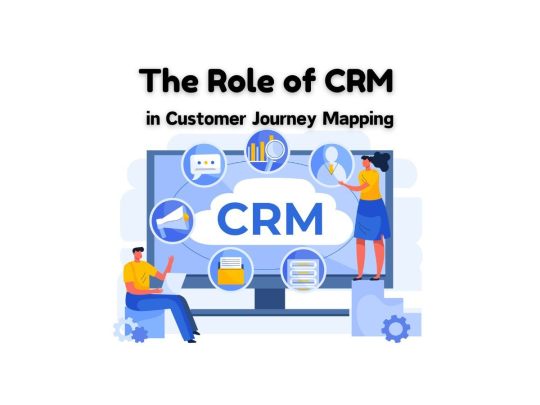
In the digital age, customers expect personalized, seamless experiences at all points of interaction with a brand. To meet this expectation, businesses must have an intimate understanding of their customers' journey. One tool that has proven invaluable in this quest is Customer Relationship Management (CRM) software.
In this blog post, we will explore how CRM plays a pivotal role in mapping the customer journey, helping businesses deliver more personalized experiences and forging stronger relationships with their customers.
Understanding Customer Journey Mapping
Customer journey mapping is the process of creating a visual representation of the customers' experience, from the first contact to the final interaction. This process allows companies to understand the steps customers go through when engaging with their brand, identify areas of strengths and weaknesses, and optimize the customer experience accordingly.
The Role of CRM in the Customer Journey
CRM software serves a critical role in customer journey mapping by providing the data and analytics necessary to create accurate, actionable maps. Here's how CRM aids in this process:
Data Gathering and Integration
First, CRM gathers data from various sources within the business and integrates them into a single platform. This data helps businesses understand more about their customers' preferences, behaviors, and needs, providing the insights required to kickstart the journey mapping process.
Building Customer Profiles
With the data collected, CRM software can build detailed customer profiles that can help form user personas. These personas serve as the foundation for the customer journey map, allowing businesses to envision the steps their typical customer might take when interacting with their brand.
Tracking Customer Interactions
CRM software tracks and records every interaction a customer has with a brand, be it via social media, phone call, email, or in-person. This trace of interactions allows businesses to map out the exact paths customers take throughout their journey, enabling a more detailed and accurate representation of the customer experience.
Analyzing Customer Behavior
CRM software also comes with analytics capabilities, enabling businesses to analyze customer behavior and identify patterns or trends. These insights make it easier to pinpoint areas within the journey where customers may encounter challenges, abandon their shopping cart, or experience a high level of satisfaction.
Personalizing Customer Experience
Equipped with a deeper understanding of the customer journey, businesses can personalize interactions and experiences at scale. Using CRM data, businesses can customize their marketing campaigns, customer service, and other touchpoints to meet unique customer needs at each stage of their journey.
Conclusion
CRM plays an instrumental role in customer journey mapping, enabling a holistic understanding of customers and their interactions with your brand. By integrating CRM in your customer journey mapping efforts, you can create personalized experiences that drive customer satisfaction and loyalty, leading to greater business success.
Remember, while CRM informs customer journey mapping, the insights must be continually analyzed, and the journey updated as customer behaviors evolve. This way, you always stay connected with your customers' experiences and can swiftly adapt to any changes, ensuring you always hold the customer's perspective at the center of your decisions.
#crm#b2bmarketing#growyourbusiness#seo#brandawareness#prospectlistbuilding#contentstrategy#keywordresearch#customer engagement
4 notes
·
View notes
Text
Benefits of Google Ads
Google Ads allows you to take advantage of the benefits of online advertising: show your ads to the right people, in the right place, and at the right time. Google Ads offers several benefits, but here are the key ones:

1. Target your ads
Targeting gives you the ability to show your ads to reach people with specific interests — namely, people who are interested in your products and services — and show them relevant ads.
Google Ads offers different ways of targeting, which we'll go over in more detail later. For now, here's a look at the choices that you have with online ads that can make your marketing campaigns even more targeted:
Keywords: Words or phrases relevant to your products and service, which are used to show your ads when customers search for those terms or visit relevant websites.
Ad location: Show your ads on Google search results pages and websites that are part of the Google Search and Display Networks.
Age, location, and language: Choose the age, geographic location, and language of your customers.
Days, times, and frequency: Show your ads during certain hours or days of the week, and determine how often your ads appear.
Devices: Your ads can appear on all types of devices, and you can fine-tune which devices your ads appear on and when.
2. Control your costs
Google Ads gives you control over how you spend your money. There’s no minimum. And you can choose how much you spend per month, per day, and per ad. You’ll only pay when someone clicks your ad.
3. Measure your success
With Google Ads, if someone clicked your ad, you’ll know. If they clicked your ad and then did something valuable to your business -- purchased your product, downloaded your app, or phoned in an order -- you can track that, too.
By seeing which ads get clicks and which ones don’t, you’ll also quickly see where to invest in your campaign. That, in turn, can boost the return on your investment.
You can get other valuable data, including how much it costs you, on average, for advertising that leads to your customers’ online purchases or phone calls. And you can also use analytical tools to learn about your customer’s shopping habits -- how long, for instance, they tend to research your product before they buy.
4. Manage your campaigns
Google Ads also offers you tools to easily manage and monitor accounts.
If you manage multiple Google Ads accounts, a My Client Center (MCC) manager account is a powerful tool that could save you time. It lets you easily view and manage all of your Google Ads accounts from a single location.
You can also manage your Google Ads account offline with Google Ads Editor, a free, downloadable desktop application that allows you to quickly and conveniently make changes to your account. With Google Ads Editor, you can download your account information, edit your campaigns offline, and then upload your changes to Google Ads. You can use Google Ads Editor to manage, edit, and view multiple accounts at the same time, copy or move items between ad groups and campaigns, and undo and redo multiple changes while editing campaigns.
Click To Hire...
#makemoney#marketingagency#marketingplan#marketingdigital#marketingmultinivel#marketingonline#videomarketing#marketing101#marketing#marketingtips#GoogleAds#GoogleAdsense#googleadsenseindonesia#googleadswords#googleadsenseclicks#googleadsword#google#googleplay#googleadwords#GooglePixel#googlesearch#googleandroid#googlemaps#googleplus#googleanalytics#GooglePixel2#googleplaystore#googleplaymusic#googlehome#googleit
13 notes
·
View notes
Text
In the United States, call center companies play a pivotal role in providing customer support, sales assistance, technical troubleshooting, and various other services for businesses across a multitude of industries. These companies employ thousands of individuals nationwide and operate through various models, including in-house, outsourced, and virtual call centers. Let's delve into the landscape of call center companies in the USA.
1. Overview of the Call Center Industry:
The call center industry in the USA has witnessed significant growth over the years, driven by the increasing demand for cost-effective customer service solutions and the globalization of businesses. Today, call centers cater to diverse sectors such as telecommunications, banking and finance, healthcare, retail, technology, and e-commerce.
2. Major Players:
Several major call center companies dominate the industry, including:
Teleperformance: One of the largest call center companies globally, Teleperformance operates numerous centers across the USA, offering multilingual customer support, technical assistance, and sales services.
Concentrix: Concentrix is another key player, known for its innovative customer engagement solutions. It provides a wide range of services, including customer care, technical support, and digital marketing services.
Alorica: Alorica specializes in customer experience outsourcing solutions, serving clients in various industries. It offers services such as customer support, sales, and back-office support.
Sitel Group: Sitel Group is renowned for its customer experience management solutions. With a global presence, Sitel operates call centers in multiple locations across the USA, providing tailored customer support services.
TTEC: Formerly known as TeleTech, TTEC offers customer experience solutions, digital services, and technology-enabled customer care. It focuses on delivering personalized customer interactions through its contact centers.
3. Industry Trends:
The call center industry is continually evolving, driven by technological advancements and changing consumer preferences. Some notable trends include:
Digital Transformation: Call centers are increasingly integrating digital channels such as chat, email, and social media to enhance customer engagement and support omnichannel experiences.
AI and Automation: Automation technologies, including artificial intelligence (AI) and chatbots, are being adopted to streamline processes, improve efficiency, and provide faster resolutions to customer queries.
Remote Workforce: The COVID-19 pandemic accelerated the shift towards remote work in the call center industry. Many companies have embraced remote workforce models, allowing agents to work from home while maintaining productivity and efficiency.
Data Analytics: Call centers are leveraging data analytics tools to gain insights into customer behavior, preferences, and trends. This data-driven approach enables them to personalize interactions and optimize service delivery.
4. Challenges and Opportunities:
Despite its growth, the call center industry faces several challenges, including:
Staffing Issues: Recruiting and retaining skilled agents remains a challenge for many call center companies, particularly amid competition for talent and high turnover rates.
Security Concerns: With the increasing prevalence of cyber threats, call centers must prioritize data security and compliance to protect sensitive customer information.
However, the industry also presents numerous opportunities for growth and innovation:
Expansion of Services: Call center companies can diversify their service offerings to meet the evolving needs of clients, such as expanding into digital customer engagement, analytics, and consulting services.
Focus on Customer Experience: By prioritizing customer experience and investing in training and technology, call centers can differentiate themselves and gain a competitive edge in the market.
Globalization: With advancements in technology and communication infrastructure, call center companies can explore opportunities for global expansion and tap into new markets.
5. Future Outlook:
Looking ahead, the call center industry is poised for further growth and transformation. As businesses increasingly prioritize customer-centric strategies, call center companies will play a crucial role in delivering exceptional customer experiences and driving business success.
In conclusion, call center companies in the USA form a vital component of the customer service ecosystem, serving a wide range of industries and helping businesses enhance customer satisfaction and loyalty. With ongoing technological innovations and evolving customer expectations, the industry is poised for continued growth and innovation in the years to come.
2 notes
·
View notes
Text
Streamlining Efficiency and Customer Satisfaction: Call Center Setup and Management Solutions
In today's fast-paced business landscape, establishing an effective call center is crucial for organizations aiming to provide exceptional customer service. A well-designed call center setup, supported by robust management solutions, can significantly enhance operational efficiency, improve customer satisfaction, and boost overall business success. This article delves into the key components of a successful call center setup and explores innovative management solutions that can optimize performance and ensure customer-centric operations.

1. Strategic Planning and Infrastructure:
A successful call center setup begins with meticulous strategic planning. Understanding the organization's objectives, target audience, and service requirements is essential for designing an efficient infrastructure. Considerations such as call volume projections, necessary hardware and software, telephony systems, and network infrastructure must be carefully assessed. Advanced technologies like cloud-based solutions can offer scalability, flexibility, and cost-effectiveness, allowing businesses to adapt to changing demands.
2. Workforce Management:
A well-managed workforce is the backbone of any call center. Efficiently scheduling agents, forecasting call volumes, and accurately estimating staffing needs are crucial for maintaining service levels and minimizing wait times. Workforce management solutions leverage sophisticated algorithms to optimize scheduling, taking into account historical data, employee skills, and service level agreements. These tools enable organizations to strike a balance between customer demand and agent availability, enhancing productivity and reducing costs.
3. Quality Monitoring and Training:
To ensure consistent service quality, call centers must invest in robust quality monitoring and training programs. Implementing call recording and evaluation systems enables supervisors to assess agent performance, identify areas for improvement, and deliver targeted coaching and training. Real-time monitoring tools provide immediate feedback, allowing supervisors to intervene and guide agents during customer interactions. Continuous training programs enhance agent knowledge, soft skills, and product expertise, ultimately leading to enhanced customer satisfaction.
4. Omnichannel Integration:
Modern call centers must embrace omnichannel communication to cater to customers' evolving preferences. Integrating multiple channels, such as voice, email, chat, social media, and self-service portals, enables seamless interactions across platforms. A unified agent desktop interface and intelligent routing systems direct inquiries to the most suitable agents, ensuring consistent service delivery regardless of the channel. Omnichannel integration improves customer convenience, reduces resolution times, and fosters a personalized and consistent customer experience.
5. Analytics and Performance Metrics:
Data-driven insights play a pivotal role in optimizing call center operations. Advanced analytics tools can track key performance metrics, such as average handling time, first call resolution, customer satisfaction scores, and agent productivity. Analyzing this data helps identify operational bottlenecks, gauge customer sentiment, and make informed decisions. Predictive analytics can even anticipate customer needs, allowing agents to proactively address concerns and improve overall service levels.
6. Continuous Improvement and Feedback Loops:
A culture of continuous improvement is vital for the long-term success of any call center. Regularly seeking feedback from customers and agents alike helps identify pain points and areas of improvement. Employee engagement programs, feedback mechanisms, and recognition initiatives create a positive work environment and motivate agents to deliver exceptional service. By fostering a feedback loop, call centers can adapt to changing customer expectations, refine processes, and innovate to stay ahead in a competitive market.
Conclusion:
Setting up and managing a call center involves a multifaceted approach that blends strategic planning, technology implementation, and effective management solutions. By prioritizing infrastructure, workforce management, quality monitoring, omnichannel integration, analytics, and continuous improvement, businesses can establish customer-centric call centers that drive operational efficiency and enhance customer satisfaction. Embracing innovative solutions and staying attuned to evolving industry trends will position organizations for success in an increasingly competitive business landscape.
Click here to check my service on Fiverr
Source:
#CallCenterSetup#CallCenterManagement#CustomerService#ContactCenter#CustomerExperience#Outsourcing#BusinessSolutions#CustomerSupport#ServiceManagement#InboundCallCenter#OutboundCallCenter#VirtualCallCenter#OmnichannelSupport#CRMIntegration#AgentTraining#EfficiencyImprovement#QualityAssurance#PerformanceMetrics#CostOptimization#TechnologyIntegration#WorkforceManagement#Analytics#ProcessImprovement#CustomerSatisfaction#ServiceLevelAgreement
8 notes
·
View notes
Text
Mastering the DevOps Landscape: A Comprehensive Exploration of Roles and Responsibilities
Embarking on a career in DevOps opens the door to a dynamic and collaborative experience centered around optimizing software development and delivery. This multifaceted role demands a unique blend of technical acumen and interpersonal skills. Let's delve into the intricate details that define the landscape of a DevOps position, exploring the diverse aspects that contribute to its dynamic nature.

1. The Synergy of Collaboration: At the core of DevOps lies a strong emphasis on collaboration. DevOps professionals navigate the intricacies of working closely with development, operations, and cross-functional teams, fostering effective communication and teamwork to ensure an efficient software development lifecycle.
2. Orchestrating End-to-End Excellence: DevOps practitioners shoulder the responsibility for the entire software delivery pipeline. From coding and testing to deployment and monitoring, they orchestrate a seamless and continuous workflow, responding promptly to changes and challenges, resulting in faster and more reliable software delivery.
3. The Automation Symphony and IaC Choreography: Automation takes center stage in DevOps practices. DevOps professionals automate repetitive tasks, enhancing efficiency and reliability. Infrastructure as Code (IaC) adds another layer, facilitating consistent and scalable infrastructure management and further streamlining the deployment process.
4. Unveiling the CI/CD Ballet: Continuous Integration (CI) and Continuous Deployment (CD) practices form the elegant dance of DevOps. This choreography emphasizes regular integration, testing, and automated deployment, effectively identifying and addressing issues in the early stages of development.
5. Monitoring and Analytics Spotlight: DevOps professionals shine a spotlight on monitoring and analytics, utilizing specialized tools to track applications and infrastructure. This data-driven approach enables proactive issue resolution and optimization, contributing to the overall health and efficiency of the system.
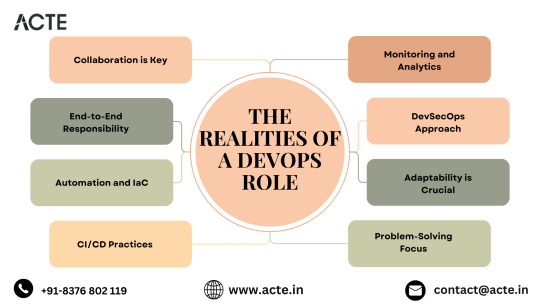
6. The Art of DevSecOps: Security is not a mere brushstroke; it's woven into the canvas of DevOps through the DevSecOps approach. Collaboration with security teams ensures that security measures are seamlessly integrated throughout the software development lifecycle, fortifying the system against vulnerabilities.
7. Navigating the Ever-Evolving Terrain: Adaptability is the compass guiding DevOps professionals through the ever-evolving landscape. Staying abreast of emerging technologies, industry best practices, and evolving methodologies is crucial for success in this dynamic environment.
8. Crafting Solutions with Precision: DevOps professionals are artisans in problem-solving. They skillfully troubleshoot issues, identify root causes, and implement solutions to enhance system reliability and performance, contributing to a resilient and robust software infrastructure.
9. On-Call Symphony: In some organizations, DevOps professionals play a role in an on-call rotation. This symphony involves addressing operational issues beyond regular working hours, underscoring the commitment to maintaining system stability and availability.
10. The Ongoing Learning Odyssey: DevOps is an ever-evolving journey of learning. DevOps professionals actively engage in ongoing skill development, participate in conferences, and connect with the broader DevOps community to stay at the forefront of the latest trends and innovations, ensuring they remain masters of their craft.
In essence, a DevOps role is a voyage into the heart of modern software development practices. With a harmonious blend of technical prowess, collaboration, and adaptability, DevOps professionals navigate the landscape, orchestrating excellence in the efficient and reliable delivery of cutting-edge software solutions.
3 notes
·
View notes
Text
Mastering Efficiency: A Deep Dive into Healthcare Scheduling Software Systems
In the quick-paced international of healthcare, effective affected person scheduling is the cornerstone of streamlined operations. The advent of healthcare scheduling software program systems has ushered in a new era of precision, optimizing affected person appointments, and remodeling the way medical facilities manipulate their calendars.
The Power of Patient Scheduling
Patient scheduling is a delicate dance in which time, accuracy, and patient pride are of the essence. Traditional scheduling methods regularly led to inefficiencies, lengthy wait times, and frustrated patients. Enter healthcare scheduling software program systems, a technological bounce that brings order to the chaos.

Key Benefits of Healthcare Scheduling Software Systems
Efficient Patient Management: These systems empower healthcare companies with tools to successfully manage affected person appointments, ensuring ultimate use of sources and decreasing idle time.
Enhanced Patient Experience: Through intuitive interfaces, patients can without problems agenda appointments at their comfort, decreasing the trouble of lengthy cellphone calls and providing a unbroken experience.
Real-time Updates: Medical scheduling software program gives actual-time updates, minimizing the threat of overbooking and offering a clear view of the day's time table for each personnel and patients.
Resource Optimization: With functions like computerized reminders and notifications, healthcare specialists can reduce no-indicates and optimize aid utilization, resulting in a extra efficient exercise.
Exploring Medical Scheduling Software Systems
Medical scheduling software is available in numerous bureaucracy, every tailor-made to meet the precise desires of healthcare providers. These structures encompass:
Patient Scheduling Software:
Tailored to patient desires, letting them time table appointments easily thru user-pleasant interfaces.
Medical Appointment Scheduling App:
Mobile-friendly solutions that empower patients to manipulate appointments on-the-move, improving accessibility.
Hospital Scheduling Software:
Robust systems designed to address the complexities of scheduling inside a medical institution surroundings, taking into account various departments and specialties.
Choosing the Right System:
Selecting an appropriate healthcare scheduling software involves cautious attention of things together with scalability, integration competencies, and consumer-friendliness. Look for structures that seamlessly integrate into existing workflows, provide comprehensive reporting functions, and cling to the best requirements of protection and compliance.
The future of prescription healthcare
As technology advances, the future of prescription healthcare looks promising. Machine learning algorithms, predictive analytics, and artificial intelligence are poised to further advance the accuracy and efficiency of planning, ultimately benefiting healthcare providers and patients
In conclusion, the adoption of healthcare software systems is a strategic path towards a more efficient, patient-centered healthcare environment. By using these tools, medical centers can improve the efficiency of their operations, reduce administrative burdens, and improve the overall patient experience. As health care continues to evolve, those skilled in the art of planning will undoubtedly be at the forefront of providing quality care.
2 notes
·
View notes
Text
In the first four months of the Covid-19 pandemic, government leaders paid $100 million for management consultants at McKinsey to model the spread of the coronavirus and build online dashboards to project hospital capacity.
It's unsurprising that leaders turned to McKinsey for help, given the notorious backwardness of government technology. Our everyday experience with online shopping and search only highlights the stark contrast between user-friendly interfaces and the frustrating inefficiencies of government websites—or worse yet, the ongoing need to visit a government office to submit forms in person. The 2016 animated movie Zootopia depicts literal sloths running the DMV, a scene that was guaranteed to get laughs given our low expectations of government responsiveness.
More seriously, these doubts are reflected in the plummeting levels of public trust in government. From early Healthcare.gov failures to the more recent implosions of state unemployment websites, policymaking without attention to the technology that puts the policy into practice has led to disastrous consequences.
The root of the problem is that the government, the largest employer in the US, does not keep its employees up-to-date on the latest tools and technologies. When I served in the Obama White House as the nation’s first deputy chief technology officer, I had to learn constitutional basics and watch annual training videos on sexual harassment and cybersecurity. But I was never required to take a course on how to use technology to serve citizens and solve problems. In fact, the last significant legislation about what public professionals need to know was the Government Employee Training Act, from 1958, well before the internet was invented.
In the United States, public sector awareness of how to use data or human-centered design is very low. Out of 400-plus public servants surveyed in 2020, less than 25 percent received training in these more tech-enabled ways of working, though 70 percent said they wanted such training.
But knowing how to use new technology does not have to be an afterthought, and in some places it no longer is. In Singapore, the Civil Service Training College requires technology and digital-skills training for its 145,000 civilian public servants. Canada’s “Busrides” training platform gives its quarter-million public servants short podcasts on topics like data science, AI, and machine learning to listen to during their commutes. In Argentina, career advancement and salary raises are tied to the completion of training in human-centered design and data-analytical thinking. When public professionals possess these skills—learning how to use technology to work in more agile ways, getting smarter from both data and community engagement—we all benefit.
Today I serve as chief innovation officer for the state of New Jersey, working to improve state websites that deliver crucial information and services. When New Jersey’s aging mainframe strained under the load of Covid jobless claims, for example, we wrote forms in plain language, simplified and eliminated questions, revamped the design, and made the site mobile-friendly. Small fixes that came from sitting down and listening to claimants translated into 48 minutes saved per person per application. New Jersey also created a Covid-19 website in three days so that the public had the information they wanted in one place. We made more than 134,000 updates as the pandemic wore on, so that residents benefited from frequent improvements.
Now with the explosion of interest in artificial intelligence, Congress is turning its attention to ensuring that those who work in government learn more about the technology. US senators Gary Peters (D-Michigan) and Mike Braun (R-Indiana) are calling for universal leadership training in AI with the AI Leadership Training Act, which is moving forward to the full Senate for consideration. The bill directs the Office of Personnel Management (OPM), the federal government's human resources department, to train federal leadership in AI basics and risks. However, it does not yet mandate the teaching of how to use AI to improve how the government works.
The AI Leadership Training Act is an important step in the right direction, but it needs to go beyond mandating basic AI training. It should require that the OPM teach public servants how to use AI technologies to enhance public service by making government services more accessible, providing constant access to city services, helping analyze data to understand citizen needs, and creating new opportunities for the public to participate in democratic decisionmaking.
For instance, cities are already experimenting with AI-based image generation for participatory urban planning, while San Francisco’s PAIGE AI chatbot is helping to answer business owners' questions about how to sell to the city. Helsinki, Finland, uses an AI-powered decisionmaking tool to analyze data and provide recommendations on city policies. In Dubai, leaders are not just learning AI in general, but learning how to use ChatGPT specifically. The legislation, too, should mandate that the OPM not just teach what AI is, but how to use it to serve citizens.
In keeping with the practice in every other country, the legislation should require that training to be free. This is already the case for the military. On the civilian side, however, the OPM is required to charge a fee for its training programs. A course titled Enabling 21st-Century Leaders, for example, costs $2,200 per person. Even if the individual applies to their organization for reimbursement, too often programs do not have budgets set aside for up-skilling.
If we want public servants to understand AI, we cannot charge them for it. There is no need to do so, either. Building on a program created in New Jersey, six states are now collaborating with each other in a project called InnovateUS to develop free live and self-paced learning in digital, data, and innovation skills. Because the content is all openly licensed and designed specifically for public servants, it can easily be shared across states and with the federal government as well.
The Act should also demand that the training be easy to find. Even if Congress mandates the training, public professionals will have a hard time finding it without the physical infrastructure to ensure that public servants can take and track their learning about tech and data. In Germany, the federal government’s Digital Academy offers a single site for digital up-skilling to ensure widespread participation. By contrast, in the United States, every federal agency has its own (and sometimes more than one) website where employees can look for training opportunities, and the OPM does not advertise its training across the federal government. While the Department of Defense has started building USALearning.gov so that all employees could eventually have access to the same content, this project needs to be accelerated.
The Act should also require that data on the outcomes of AI training be collected and published. The current absence of data on federal employee training prevents managers, researchers, and taxpayers from properly evaluating these training initiatives. More comprehensive information about our public workforce, beyond just demographics and job titles, could be used to measure the impact of AI training on cost savings, innovation, and performance improvements in serving the American public.
Unlike other political reforms that could take generations to achieve in our highly partisan and divisive political climate, investing in people—teaching public professionals how to use AI and the latest technology to work in more agile, evidence-based, and participatory ways to solve problems—is something we can do right now to create institutions that are more responsive, reliable, and deserving of our trust.
I understand the hesitance to talk about training people in government. When I worked for the Obama White House, the communications team was reluctant to make any public pronouncements about investing in government lest we be labeled “Big Government” advocates. Since the Reagan years, Republicans have promoted a “small government” narrative. But what matters to most Americans is not big or small but that we have a better government.
6 notes
·
View notes
Text
Navigating 'The Heartbeat': A User-Friendly Guide to Call Analytics
Introduction:
In today's digital world, understanding how customers act and looking at call data is super important for businesses. Call analytics helps businesses get useful information, making them grow and make customers happier. But with so many tools out there, choosing the right one can be tough.
Discovering 'The Heartbeat':
I heard about 'The Heartbeat' from a friend in the industry. People were talking about its smart insights and how well it fits with other tools. Interested, I decided to check it out to see if it was what I needed.
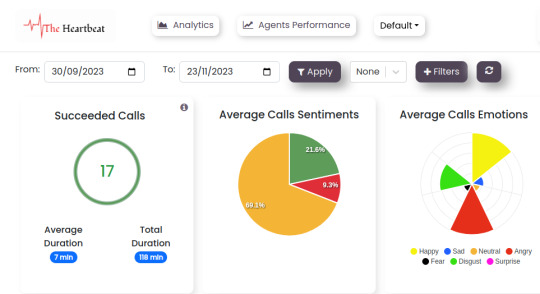
Features and Abilities:
'The Heartbeat' has some cool features. It can understand speech really well, predict things, and even listen in on live calls. What makes it special is how deeply it looks into conversations. Unlike other tools that just scratch the surface, 'The Heartbeat' really gets what people are talking about, thanks to its Call Quality Score.
One cool thing is how efficient it is. It doesn't just help with customer stuff but also makes products better and saves money. And it keeps things safe by hiding private data.

Trying It Out:
Using 'The Heartbeat' was easy. The way it works is easy to understand, and it links up with cloud storage like Google Drive and OneDrive, so you don't have to spend time putting in data by hand. I remember a time when I wanted to figure out what customers were saying. 'The Heartbeat' quickly sorted it out and gave me ideas to fix things.

Benefits Seen:
After using 'The Heartbeat,' our call center got much better. The smart insights it gives us have made us smarter in business, and our workers are doing a better job. Knowing how customers feel right away helps us fix things fast and keeps customers happy.
Comparing to Others:
I've tried a few tools before, but 'The Heartbeat' is way better. It goes really deep into conversations, unlike other tools that only look at a small part. It's easy to use, and that's a big plus.
Challenges and Suggestions:
No tool is perfect. I had a few issues getting everything to work, but the support team fixed it fast. One thing I'd like to see in the future is a chatbot to help with problems right away.

Conclusion:
In the world of call analytics, 'The Heartbeat' stands out. It's smart and easy to use, making it a must for businesses. I would tell others to use it, and I'm excited to see what new things they come up with.
You can also register and start a free trial: The HeartBeat
5 notes
·
View notes
Text



Researchers find gravitational lensing has significant effect on cosmic birefringence
Future missions will be able to find signatures of violating the parity-symmetry in the cosmic microwave background polarization more accurately after a pair of researchers has managed to take into account the gravitational lensing effect, reports a new study in Physical Review D, selected as an Editors' Suggestion.
How far does the universe extend? When and how did the universe begin? Cosmology has made progress in addressing these questions by providing observational evidence for theoretical models of the universe based on fundamental physics. The Standard Model of Cosmology is widely accepted by researchers today. However, it still cannot explain fundamental questions in cosmology, including dark matter and dark energy.
In 2020, an interesting new phenomenon called cosmic birefringence was reported from the cosmic microwave background (CMB) polarization data. Polarization describes light waves oscillating perpendicularly to the direction it is traveling. In general, the direction of polarization plane remains constant, but can be rotated under special circumstances.
A reanalysis of the CMB data showed the polarization plane of the CMB light may have slightly rotated between the time it was emitted in the early universe and today. This phenomenon violates the parity symmetry and is called the cosmic birefringence.
Because cosmic birefringence is challenging to explain with the well-known physical laws, there is a strong possibility that yet to be discovered physics, such as the axionlike particles (ALPs), lies behind it. A discovery of cosmic birefringence could lead the way to revealing the nature of dark matter and dark energy, and so future missions are focused on making more precise observations of the CMB.
To do this, it is important to improve the accuracy of current theoretical calculations, but these calculations so far have not been sufficiently accurate because they do not take gravitational lensing into account.
A new study by a pair of researchers, led by The University of Tokyo Department of Physics and Research Center for Early Universe doctoral student Fumihiro Naokawa, and Center for Data-Driven Discovery and Kavli Institute for the Physics and Mathematics of the Universe (Kavli IPMU) Project Assistant Professor Toshiya Namikawa, established a theoretical calculation of cosmic birefringence that incorporates gravitational lensing effects, and worked on the development of a numerical code for cosmic birefringence that includes gravitational lensing effects, which will be indispensable for future analyses.
First, Naokawa and Namikawa derived an analytical equation describing how the gravitational lensing effect changes the cosmic birefringence signal. Based on the equation, the researchers implemented a new program to an existing code to compute the gravitational lensing correction, and then looked at the difference in signals with and without the gravitational lensing correction.
As a result, the researchers found that if gravitational lensing is ignored, the observed cosmic birefringence signal cannot be fitted well by the theoretical prediction, which would statistically reject the true theory.
In addition, the pair created simulated observational data that will be obtained in future observations to see the effect of gravitational lensing in the search for ALPs. They found that if the gravitational lensing effect is not considered, there would be statistically significant systematic biases in the model parameters of ALPs estimated from the observed data, which would not accurately reflect the ALPs model.
The gravitational lensing correction tool developed in this study is already being used in observational studies today, and Naokawa and Namikawa will continue to use it to analyze data for future missions.
TOP IMAGE....Cosmic Microwave Background (CMB) polarized light subjected to gravitational lensing effects, in addition to cosmic birefringence. On the far left, the white lines show the polarization pattern of the CMB light generated in the early universe. These rotate due to cosmic birefringence, resulting in the currently observed CMB depicted by the black lines on the right side of the image. However, the path of light is bent by the gravitational distortion of space-time created by the large-scale structure in the middle, and so the white lines showing the polarization pattern on the right side of the image shows what is observed. Credit: Physical Review D (2023). DOI: 10.1103/PhysRevD.108.063525
CENTRE IMAGE....Simons Observatory in Chile. Credit: Debra Kellner
LOWER IMAGE....The difference in the cosmic birefringence signal with and without gravitational lensing. The blue dots show the signals when the gravitational lensing effect is ignored, and the red dots are the signals when the gravitational lensing effect is considered. The red error bars show the expected observation errors when the Simons Observatory will be used. The difference with and without gravitational lensing is not negligible. Credit: Physical Review D (2023). DOI: 10.1103/PhysRevD.108.063525
2 notes
·
View notes
Text
Leveraging Sales and Call Center Analytics Tools
Leveraging Sales and Call Center Analytics Tools: A Pathway to Transformative Customer Interactions
In the intricate ecosystem of sales and customer service, the adoption of advanced analytics tools has emerged as a game-changer, revolutionizing the way businesses approach customer interactions and sales strategies. Sales analytics tools and call center analytics are at the forefront of this transformation, offering insights that pave the way for optimized sales processes, enhanced customer experiences, and ultimately, increased revenue. This comprehensive blog explores the significance of these tools, their impact on sales and customer service, and how businesses can harness their potential to drive success.
The Rise of Sales Analytics Tools
Sales analytics tools are sophisticated software solutions designed to analyze sales data and generate actionable insights. These tools delve into sales performance, customer behavior, market trends, and more, enabling businesses to make data-driven decisions that boost sales efficiency and effectiveness.
Transforming Sales Strategies with Data-Driven Insights
Sales analytics tools empower businesses to identify successful sales patterns, forecast future sales, and pinpoint areas needing improvement. By analyzing data on customer interactions, purchase history, and preferences, these tools help sales teams tailor their strategies to meet customer needs more effectively. This customization not only enhances the customer experience but also increases the likelihood of closing sales.
Enhancing Productivity and Performance
One of the key benefits of sales analytics tools is their ability to enhance sales team productivity. By automating data analysis, these tools save time and resources, allowing sales professionals to focus on engaging with prospects and clients. Furthermore, sales analytics can identify the most promising leads and opportunities, ensuring that efforts are concentrated where they are most likely to yield results.
The Strategic Value of Call Center Analytics
Call center analytics extend beyond traditional metrics such as call volumes and average handling times, providing a deeper understanding of customer interactions and satisfaction. These tools analyze voice and text communications, offering insights into customer sentiments, agent performance, and operational efficiency.
Elevating Customer Service Experience
Call center analytics tools are instrumental in elevating the customer service experience. By identifying common issues and trends in customer calls, businesses can proactively address problems and improve their products or services. Additionally, sentiment analysis can gauge customer emotions, enabling agents to adjust their approach in real-time, fostering a more positive customer experience.
Optimizing Call Center Operations
Beyond improving customer interactions, call center analytics can optimize overall operations. Insights into call patterns and peak times allow for better staff allocation, reducing wait times and improving service levels. Furthermore, analyzing agent performance helps identify training needs, enhancing the effectiveness of customer service teams.
Integrating Sales and Call Center Analytics for Comprehensive Insights
The integration of sales and call center analytics offers a holistic view of the customer journey, from initial contact through to post-sales support. This integrated approach enables businesses to align their sales and customer service strategies, ensuring a seamless and satisfying customer experience.
Creating a Unified Customer View
By combining insights from sales and call center interactions, businesses can create a unified view of the customer. This comprehensive understanding allows for personalized communication and offers, increasing customer engagement and loyalty. A unified view also facilitates the identification of cross-sell and upsell opportunities, contributing to revenue growth.
Leveraging Analytics for Continuous Improvement
Continuous improvement is vital in today's competitive market. Sales and call center analytics provide the data needed to continuously refine and enhance sales strategies and customer service practices. By regularly analyzing performance and customer feedback, businesses can stay ahead of trends and adapt to changing customer needs.
Implementing Analytics Tools: Best Practices
To fully leverage the benefits of sales and call center analytics, businesses should consider the following best practices:
Choose the Right Tools: Select analytics tools that align with your business goals and integrate seamlessly with existing systems.
Train Your Team: Ensure that your team is trained to use analytics tools effectively, understanding how to interpret data and apply insights.
Focus on Data Quality: High-quality, accurate data is essential for meaningful analysis. Implement processes to ensure data integrity.
Act on Insights: Analytics is not just about gathering data; it's about taking action. Implement changes based on insights to drive improvements.
Monitor and Adapt: The business landscape is ever-changing. Regularly review analytics outcomes and be prepared to adapt strategies as necessary.
Conclusion
In the age of data-driven decision-making, sales analytics tools and call center analytics are indispensable for businesses aiming to enhance their sales strategies and customer service experiences. These tools offer invaluable insights that can transform customer interactions, streamline operations, and boost sales performance. By integrating sales and call center analytics, businesses can gain a comprehensive understanding of their customers, enabling personalized, efficient, and effective interactions. Implementing these analytics tools, coupled with a commitment to continuous improvement and best practices, can unlock new opportunities for growth and success. In embracing these technologies, businesses can navigate the complexities of the modern market, delivering exceptional value to their customers and achieving sustained competitive advantage.
0 notes
Text
A Complete Guide to Mastering Microsoft Azure for Tech Enthusiasts
With this rapid advancement, businesses around the world are shifting towards cloud computing to enhance their operations and stay ahead of the competition. Microsoft Azure, a powerful cloud computing platform, offers a wide range of services and solutions for various industries. This comprehensive guide aims to provide tech enthusiasts with an in-depth understanding of Microsoft Azure, its features, and how to leverage its capabilities to drive innovation and success.
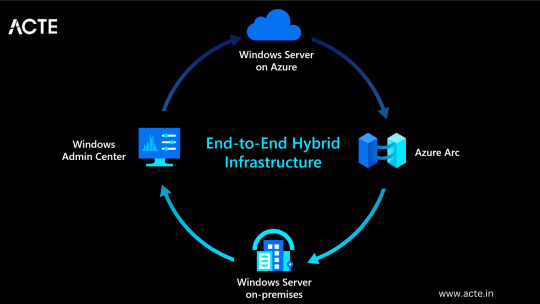
Understanding Microsoft Azure
A platform for cloud computing and service offered through Microsoft is called Azure. It provides reliable and scalable solutions for businesses to build, deploy, and manage applications and services through Microsoft-managed data centers. Azure offers a vast array of services, including virtual machines, storage, databases, networking, and more, enabling businesses to optimize their IT infrastructure and accelerate their digital transformation.
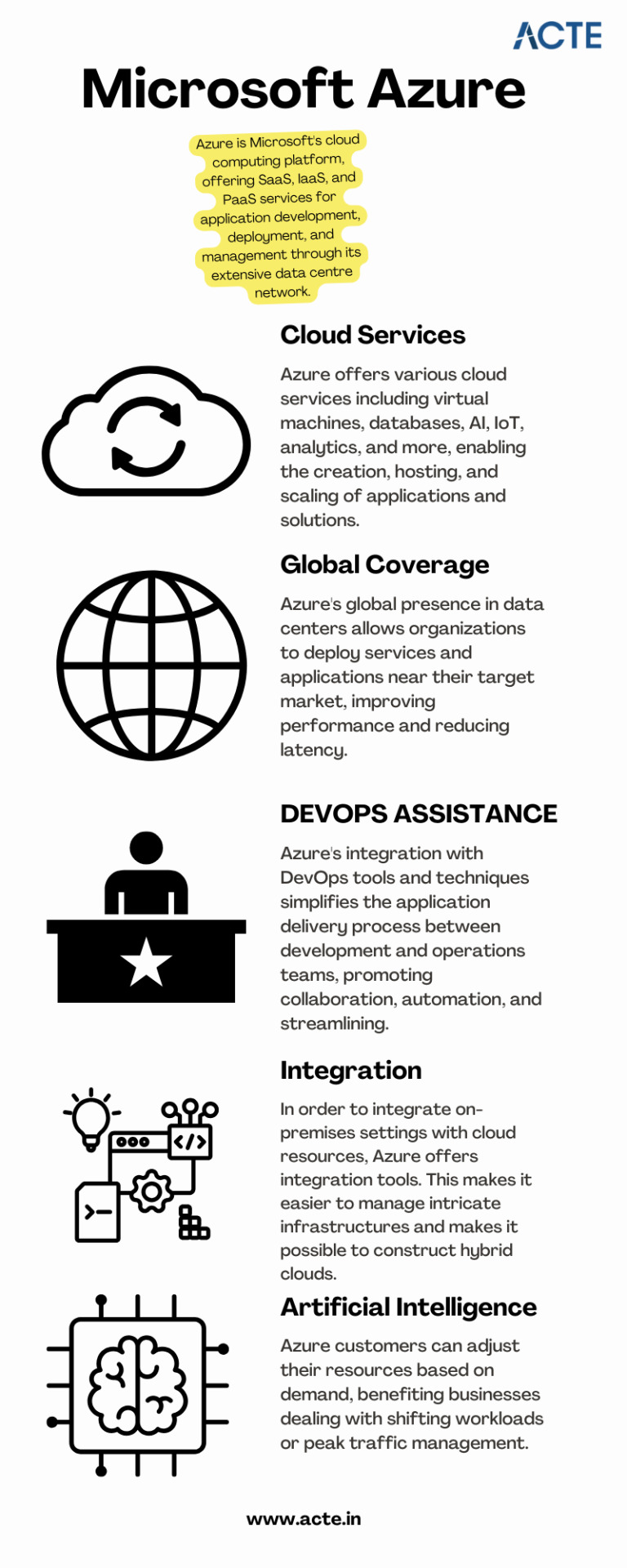
Cloud Computing and its Significance
Cloud computing has revolutionized the IT industry by providing on-demand access to a shared pool of computing resources over the internet. It eliminates the need for businesses to maintain physical hardware and infrastructure, reducing costs and improving scalability. Microsoft Azure embraces cloud computing principles to enable businesses to focus on innovation rather than infrastructure management.
Key Features and Benefits of Microsoft Azure
Scalability: Azure provides the flexibility to scale resources up or down based on workload demands, ensuring optimal performance and cost efficiency.
Vertical Scaling: Increase or decrease the size of resources (e.g., virtual machines) within Azure.
Horizontal Scaling: Expand or reduce the number of instances across Azure services to meet changing workload requirements.
Reliability and Availability: Microsoft Azure ensures high availability through its globally distributed data centers, redundant infrastructure, and automatic failover capabilities.
Service Level Agreements (SLAs): Guarantees high availability, with SLAs covering different services.
Availability Zones: Distributes resources across multiple data centers within a region to ensure fault tolerance.
Security and Compliance: Azure incorporates robust security measures, including encryption, identity and access management, threat detection, and regulatory compliance adherence.
Azure Security Center: Provides centralized security monitoring, threat detection, and compliance management.
Compliance Certifications: Azure complies with various industry-specific security standards and regulations.
Hybrid Capability: Azure seamlessly integrates with on-premises infrastructure, allowing businesses to extend their existing investments and create hybrid cloud environments.
Azure Stack: Enables organizations to build and run Azure services on their premises.
Virtual Network Connectivity: Establish secure connections between on-premises infrastructure and Azure services.
Cost Optimization: Azure provides cost-effective solutions, offering pricing models based on consumption, reserved instances, and cost management tools.
Azure Cost Management: Helps businesses track and optimize their cloud spending, providing insights and recommendations.
Azure Reserved Instances: Allows for significant cost savings by committing to long-term usage of specific Azure services.
Extensive Service Catalog: Azure offers a wide range of services and tools, including app services, AI and machine learning, Internet of Things (IoT), analytics, and more, empowering businesses to innovate and transform digitally.
Learning Path for Microsoft Azure
To master Microsoft Azure, tech enthusiasts can follow a structured learning path that covers the fundamental concepts, hands-on experience, and specialized skills required to work with Azure effectively. I advise looking at the ACTE Institute, which offers a comprehensive Microsoft Azure Course.

Foundational Knowledge
Familiarize yourself with cloud computing concepts, including Infrastructure as a Service (IaaS), Platform as a Service (PaaS), and Software as a Service (SaaS).
Understand the core components of Azure, such as Azure Resource Manager, Azure Virtual Machines, Azure Storage, and Azure Networking.
Explore Azure architecture and the various deployment models available.
Hands-on Experience
Create a free Azure account to access the Azure portal and start experimenting with the platform.
Practice creating and managing virtual machines, storage accounts, and networking resources within the Azure portal.
Deploy sample applications and services using Azure App Services, Azure Functions, and Azure Containers.
Certification and Specializations
Pursue Azure certifications to validate your expertise in Azure technologies. Microsoft offers role-based certifications, including Azure Administrator, Azure Developer, and Azure Solutions Architect.
Gain specialization in specific Azure services or domains, such as Azure AI Engineer, Azure Data Engineer, or Azure Security Engineer. These specializations demonstrate a deeper understanding of specific technologies and scenarios.
Best Practices for Azure Deployment and Management
Deploying and managing resources effectively in Microsoft Azure requires adherence to best practices to ensure optimal performance, security, and cost efficiency. Consider the following guidelines:
Resource Group and Azure Subscription Organization
Organize resources within logical resource groups to manage and govern them efficiently.
Leverage Azure Management Groups to establish hierarchical structures for managing multiple subscriptions.
Security and Compliance Considerations
Implement robust identity and access management mechanisms, such as Azure Active Directory.
Enable encryption at rest and in transit to protect data stored in Azure services.
Regularly monitor and audit Azure resources for security vulnerabilities.
Ensure compliance with industry-specific standards, such as ISO 27001, HIPAA, or GDPR.
Scalability and Performance Optimization
Design applications to take advantage of Azure’s scalability features, such as autoscaling and load balancing.
Leverage Azure CDN (Content Delivery Network) for efficient content delivery and improved performance worldwide.
Optimize resource configurations based on workload patterns and requirements.
Monitoring and Alerting
Utilize Azure Monitor and Azure Log Analytics to gain insights into the performance and health of Azure resources.
Configure alert rules to notify you about critical events or performance thresholds.
Backup and Disaster Recovery
Implement appropriate backup strategies and disaster recovery plans for essential data and applications.
Leverage Azure Site Recovery to replicate and recover workloads in case of outages.
Mastering Microsoft Azure empowers tech enthusiasts to harness the full potential of cloud computing and revolutionize their organizations. By understanding the core concepts, leveraging hands-on practice, and adopting best practices for deployment and management, individuals become equipped to drive innovation, enhance security, and optimize costs in a rapidly evolving digital landscape. Microsoft Azure’s comprehensive service catalog ensures businesses have the tools they need to stay ahead and thrive in the digital era. So, embrace the power of Azure and embark on a journey toward success in the ever-expanding world of information technology.
#microsoft azure#cloud computing#cloud services#data storage#tech#information technology#information security
6 notes
·
View notes
Text
Mastering the Art of Digital Marketing: Unleash Your Brand's Potential
In today's fast-paced digital landscape, the power of effective digital marketing cannot be overstated. With the world at our fingertips, businesses have an unparalleled opportunity to connect, engage, and convert their target audience like never before. Digital marketing has evolved into a dynamic and ever-changing realm that demands strategic finesse and creativity.
Content is King, Context is Queen: Crafting Compelling Narratives
At the heart of successful digital marketing lies the creation of engaging and relevant content. Whether it's an insightful blog post, an attention-grabbing social media update, or a captivating video, content is the driving force behind customer engagement. However, context is equally important. Understanding your audience's preferences, pain points, and behaviors is crucial in tailoring your content for maximum impact.
Social Media Sorcery: Building Brand Loyalty
Social media platforms have transformed into powerful tools for brand-building and customer interaction. With billions of active users, platforms like Facebook, Instagram, Twitter, and LinkedIn offer unique avenues for showcasing your brand's personality, sharing valuable insights, and directly connecting with your audience. Authenticity and consistency are key here – your social media presence should reflect your brand's values and resonate with your audience.
SEO: Navigating the Search Engine Maze
Search Engine Optimization (SEO) is the cornerstone of driving organic traffic to your digital assets. By optimizing your website's content, structure, and user experience, you can improve your chances of ranking higher on search engine results pages. Keep up with the latest SEO trends and algorithms to ensure your website remains visible and accessible to your target audience.
PPC and SEM: Maximizing Visibility
Pay-Per-Click (PPC) and Search Engine Marketing (SEM) campaigns allow you to place your brand front and center on search engine results pages. These targeted ads can drive immediate traffic to your website, making them an effective tool for boosting visibility and driving conversions. However, careful keyword research and constant monitoring are essential to ensure your budget is well-spent.
Email Marketing: The Personal Touch in the Digital Age
Email marketing remains a potent tool for nurturing leads and maintaining customer relationships. Crafting personalized, value-driven email campaigns can keep your brand top-of-mind, drive repeat business, and foster customer loyalty.
Data-Driven Decision Making: The Analytics Advantage
The digital realm offers a treasure trove of data that can inform and refine your marketing strategies. Utilize analytics tools to track website traffic, user behavior, and campaign performance. By analyzing this data, you can gain valuable insights into what's working and what needs adjustment.
In conclusion, digital marketing is an ever-evolving landscape that requires a strategic approach and a willingness to adapt. By harnessing the power of engaging content, leveraging social media, mastering SEO and SEM, utilizing email marketing, and making data-driven decisions, you can unlock your brand's full potential and thrive in the digital era. Embrace the opportunities that digital marketing presents, and watch as your brand flourishes in the online realm.
For a free marketing strategy call:
CLICK HERE
2 notes
·
View notes
Text

Revolutionizing Customer Support: Unlock Success with Inbound Call Center Solutions
Unlock success in revolutionizing customer support with inbound call center solutions. Experience advanced call analytics, real-time monitoring, and customer-centric support.
Elevate your customer service game with the right tools and strategies.
For more information : https://www.ringflow.com/products/inbound-call-center/
Contact Us :
👉 Email:- [email protected]
👉 WhatsApp:- 1 917-254-4289
#ExceptionalCustomerService#InboundCallCenter#CallRouting#IVRSystems#SkilledAgents#OptimizingCustomerExperience#CallDistribution#PersonalizedInteractions#QueryResolution#RevolutionizingCustomerSupport
1 note
·
View note
Text
Empowering Business Communication: Exploring Contaque's Messaging Solutions
Contaque's Messaging Solutions provide a comprehensive suite of tools and technologies that enable businesses to interact with their audience and communicate efficiently like never before. Read this blog to know more.
0 notes